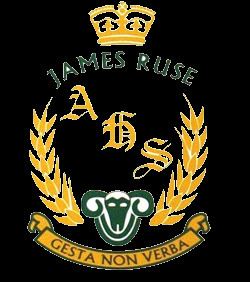Nationality British Phone +61 2 9871 7126 Name James Ruse | Spouse(s) Elizabeth Parry Occupation Farmer, Convict Founded 1956 | |
 | ||
Similar Baulkham Hills High School, Cumberland High School, Muirfield High School, John Purchase Public School, Merrylands High School | ||
How to Be a Smart Cotton Farmer James Ruse High School
James Ruse (9 August /1760 – 5 September 1837) was a Cornish farmer who, at the age of 23, was convicted of breaking and entering and was sentenced to seven years' transportation to Australia. He arrived at Sydney Cove on the First Fleet with 18 months of his sentence remaining. Ruse applied to Governor Arthur Phillip (of the colony) for a land grant, stating that he had been bred to farming. Governor Phillip, desperate to make the colony self-sufficient, allocated Ruse an allotment at Ruse Hill (now Rose Hill near Parramatta), where he proved himself industrious and showed that it was possible for a family to survive through farming. Having done this, Ruse received a grant of 30 acres (120,000 m2), enabling him eventually to sell 600 bushels of corn. This was the very first grant of land in New South Wales. Ruse later exchanged the grant for more fertile land on the Hawkesbury River. In later life, having been almost bankrupted from his farm by flooding, Ruse found work as a seaman and later a farm overseer.
Contents
- How to Be a Smart Cotton Farmer James Ruse High School
- James Ruse Awards Day Speech Living Your Dreams What I Wish I Knew in High School
- Early life
- As a pioneering farmer
- Family life
- Legacy
- References
James Ruse Awards Day Speech - Living Your Dreams: What I Wish I Knew in High School
Early life
James Ruse was born at Launceston, Cornwall, England on 9 August 1760. In 1782, he was tried at Bodmin Assizes and sentenced to death for "burglariously breaking and entering the dwelling house of Thomas Olive and stealing thereout 2 silver watches and other goods." He was reprieved and sentenced to transportation for seven years. He was sent on the Scarborough, one of the First Fleet, and arrived in New South Wales on 19 January 1788.
As a pioneering farmer
In 1789 Ruse produced the first successful corn harvest in New South Wales. Whilst this harvest didn't yield sufficient corn to feed the colony, Ruse did produce enough seeds for the next year's crop, which was successful. Such was the colony's need for a food supply, that Governor Phillip rewarded Ruse for his success with the first land grant made in New South Wales, along with a gift of pigs and chickens. In February 1791, Ruse declared to the authorities that he was self-sufficient, and two months later, in March, he was granted a further 30 acres. Ruse expected to reap about eight bushels (290 litres) to the acre. After Ruse's sentence expired in 1792, the title of his land was deeded to him, the first land grant in the colony. In 1793, he sold his land to Dr. John Harris of the New South Wales Corps for 40 pounds. The property is now the Experiment Farm Cottage Museum of the National Trust of Australia.
In 1794, Ruse moved further out, to the junction of the Hawkesbury River with South Creek, and became a fairly successful farmer. He and Elizabeth raised seven children, two of whom were thought to have been adopted. Later, however, his livelihood was wiped out by flooding, which was always the risk of farming in the Hawkesbury, and had to find work as a seaman. He was heavily in debt and only the hard work of his wife saved him from bankruptcy. From 1828, he was employed as an overseer by a landowner at Minto, south of Sydney. He died at Campbelltown on 5 September 1837.
Ruse's gravestone, parts of which he carved himself, reads:
"Gloria in Axcelsis
SACRED TO THE MEMEREY OF JAMES RUSE WHO DEPARTED THIS LIFE SEPT. 5TH IN THE YEAR OF HOURE LORD 1837 NATEF OF CORNWELL AND ARIVED IN THIS COLENEY BY THE FIRST FLEET AGED 77
MY MOTHER REREAD ME TENDERELY WITH ME SHE TOCK MUCH PAINES AND WHEN I ARIVED IN THIS COELNEY I SOWD THE FORST GRAIN AND NOW WITH MY HEVENLY FATHER I HOPE
Family life
Ruse married fellow convict Elizabeth Parry (1769 – 27 May 1836) on 5 September 1790. They had six children together – Rebecca (1791 – 9 November 1792), James (b. 1793), Elizabeth (b. 1794), Susannah (1796–1872), Mary (b. 1798) and Ann.
Legacy
A replica of this tombstone stands in the front garden of Barrengarry House, the administration block at James Ruse Agricultural High School. The original headstone carved by James Ruse himself, was moved by his descendents to a secure location after vandals damaged some headstones in the Old St Johns cemetery at Campbelltown NSW. The headstone is now in the care of The Campbelltown and Airds Historical Society at Glenalvon House in Lithgow Street Campbelltown. The memory of James Ruse is perpetuated in the naming of key locations in Sydney, including James Ruse Agricultural High School in Carlingford; James Ruse Drive, running from Silverwater to Northmead, near Parramatta; and Ruse, a suburb in southwest Sydney.
In 1980, the noted Cornish folk singer Brenda Wootton, wrote and recorded the song "James Ruse" which uses as the chorus the last four lines of the tombstone inscription.
